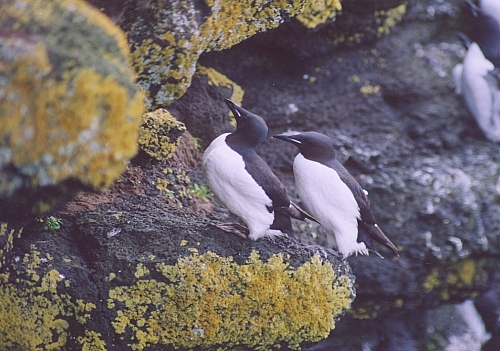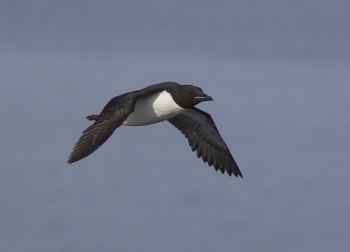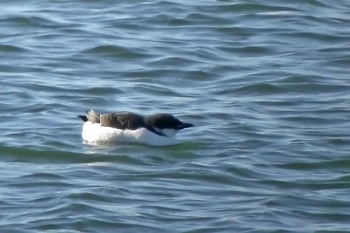m |
(Attempt to disguise copied text. Flight & winter plumage photos. Distribution expanded. Taxonomy, References) |
||
| Line 1: | Line 1: | ||
{{incomplete}} | {{incomplete}} | ||
| − | [[Image:Thick-billed_Murre.jpg|thumb|550px|right|Photo by Sungrebe]] | + | [[Image:Thick-billed_Murre.jpg|thumb|550px|right|Photo by {{user|Sungrebe|Sungrebe}}<br />St Paul Island, [[Alaska]], July 2004]] |
'''Alternative name: Brunnich's Guillemot''' | '''Alternative name: Brunnich's Guillemot''' | ||
;[[:Category:Uria|Uria]] lomvia | ;[[:Category:Uria|Uria]] lomvia | ||
==Identification== | ==Identification== | ||
| − | 40-44cm | + | 40-44cm |
| + | *Black head, neck, back and wings | ||
| + | *White underparts | ||
| + | *Long and pointed bill | ||
| + | *Small rounded black tail<br /> | ||
| + | [[Image:Brunnichs Guillemot.jpg|thumb|350px|right|<br />Photo by {{user|NIGHTJAR1|NIGHTJAR1}}<br />Spitzbergen, [[Norway]], June 2007]] | ||
| + | '''Non-breeding''': face shows more white | ||
==Distribution== | ==Distribution== | ||
| − | + | Arctic areas of [[Europe]], [[Asia]] and [[North America]]:<br /> | |
| + | '''North America''': [[Canada]], [[Newfoundland]], [[Nova Scotia]], [[New England]], [[Alaska]], [[Aleutian Islands]]<br /> | ||
| + | '''Europe''': [[Iceland]], [[Scandinavia]], [[Norway]], [[Finland]], [[Faroe Islands]], [[Greenland]], [[Baltic States|Baltic]]<br /> | ||
| + | '''Asia''': [[Russia]], [[Siberia]], [[Japan]] | ||
==Taxonomy== | ==Taxonomy== | ||
| − | + | ====Subspecies<sup>[[#References|[1]]]</sup>==== | |
| + | There are 4 subspecies: | ||
| + | *''U. l. lomvia'': | ||
| + | :*Gulf of St. Lawrence to [[Greenland]] and Novaya Zemlya | ||
| + | *''U. l. eleonorae'': | ||
| + | :*Eastern Taymyr Peninsula to New Siberian Islands ([[Russia]]) | ||
| + | *''U. l. heckeri'': | ||
| + | :*Wrangel Island, Herald Island and northern Chukotsk Peninsula | ||
| + | *''U. l. arra'': | ||
| + | :*Northern [[Japan]] and [[Aleutian Islands]] to south-eastern [[Alaska]] | ||
| + | [[Image:1461DSCN5795web-sm.jpg|thumb|350px|right|Winter plumage<br />Photo by {{user|rb_stern|rb_stern}}<br />Lunenburg, NS, [[Canada]], February 2005 ]] | ||
==Habitat== | ==Habitat== | ||
| − | + | Pelagic. Breeds on rocky seaside cliffs. | |
==Behaviour== | ==Behaviour== | ||
| − | + | ====Breeding==== | |
| − | + | Colonial breeders on cliff edges. The lay a single egg. | |
| − | They | + | ====Diet==== |
| + | They find their food underwater, in deep dives. The diet includes invertebrates and occasionally fish; the chicks are fed fish, squid, crustaceans and other small invertebrates. | ||
====Vocalisation==== | ====Vocalisation==== | ||
<flashmp3>Uria lomvia (song).mp3</flashmp3><br /> | <flashmp3>Uria lomvia (song).mp3</flashmp3><br /> | ||
''[[Media:Uria lomvia (song).mp3|Listen in an external program]]'' | ''[[Media:Uria lomvia (song).mp3|Listen in an external program]]'' | ||
| + | ==References== | ||
| + | #{{Ref-Clements6thDec09}}#Avibase | ||
| + | #Wikipedia | ||
| + | {{ref}} | ||
==External Links== | ==External Links== | ||
{{GSearch|Uria+lomvia}} | {{GSearch|Uria+lomvia}} | ||
Revision as of 09:01, 28 June 2010
| This article is incomplete. This article is missing one or more sections. You can help the BirdForum Opus by expanding it. |
Alternative name: Brunnich's Guillemot
- Uria lomvia
Identification
40-44cm
- Black head, neck, back and wings
- White underparts
- Long and pointed bill
- Small rounded black tail
Non-breeding: face shows more white
Distribution
Arctic areas of Europe, Asia and North America:
North America: Canada, Newfoundland, Nova Scotia, New England, Alaska, Aleutian Islands
Europe: Iceland, Scandinavia, Norway, Finland, Faroe Islands, Greenland, Baltic
Asia: Russia, Siberia, Japan
Taxonomy
Subspecies[1]
There are 4 subspecies:
- U. l. lomvia:
- Gulf of St. Lawrence to Greenland and Novaya Zemlya
- U. l. eleonorae:
- Eastern Taymyr Peninsula to New Siberian Islands (Russia)
- U. l. heckeri:
- Wrangel Island, Herald Island and northern Chukotsk Peninsula
- U. l. arra:
- Northern Japan and Aleutian Islands to south-eastern Alaska
Habitat
Pelagic. Breeds on rocky seaside cliffs.
Behaviour
Breeding
Colonial breeders on cliff edges. The lay a single egg.
Diet
They find their food underwater, in deep dives. The diet includes invertebrates and occasionally fish; the chicks are fed fish, squid, crustaceans and other small invertebrates.
Vocalisation
<flashmp3>Uria lomvia (song).mp3</flashmp3>
Listen in an external program
References
- Clements, JF. 2009. The Clements Checklist of Birds of the World. 6th ed., with updates to December 2009. Ithaca: Cornell Univ. Press. ISBN 978-0801445019.
- Avibase
- Wikipedia
Recommended Citation
- BirdForum Opus contributors. (2024) Thick-billed Murre. In: BirdForum, the forum for wild birds and birding. Retrieved 11 June 2024 from https://www.birdforum.net/opus/Thick-billed_Murre
External Links
This link searches for videos titled Brunnich's Guillemot






